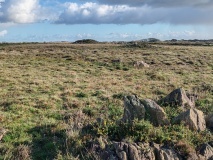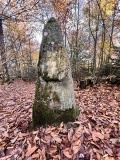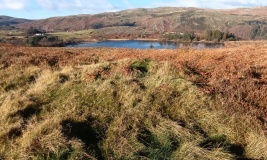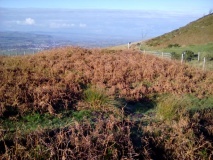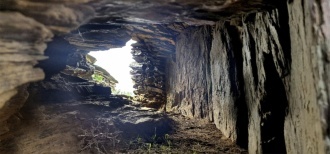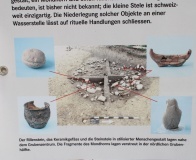Andy Burnham's Blog
November 30, 2025
Trewithno Tumuli
Three bowl barrows, situated on the south western side of Goonhilly Downs. One, seen here in the immediate foreground is built on a rock outcrop. They form part of an extensive and dispersed round barrow cemetery. These barrows survive as circular mounds surrounded by buried quarry ditches, from which their construction material was derived. They range in size from 17m up to 21m in diameter and from 1.3m to 1.5m high.
Published on November 30, 2025 10:03
Dolmen du Poulguin
An interesting rock formation in the woods along the Anse de Poulguin (southern side) in Finistère. Although named a 'dolmen' it looks to be a natural rock formation.
Published on November 30, 2025 08:42
November 28, 2025
Mollberg Menhir
The standing stone is situated in the forest west of the village of Mollberg in Bas-Rhin. It is part of the "Sentier des Demoiselles de Pierre" hiking trail. There are many other modern standing stones besides this trail which are used as a waymarkers. So I'm not sure if this stone is modern or ancient. Nearby the stone is a board with informations about the megalithic era.
Published on November 28, 2025 08:11
November 26, 2025
Cefn Caer Euni Round Cairn 1
Situated along the Cefn Caer Euni (an undulating ridge 369.2m at its highest) and with Llyn Caer Euni visible to the west the cairn occupies a natural shelf on otherwise westerly sloping ground. This is an upland moor and there are several round cairns and other monuments along the ridge. See our nearby sites list from this page for more cairns Alan has posted.
Published on November 26, 2025 09:55
November 25, 2025
Llanarmon Yn Lal Burial Mounds
Prof. Howard Williams visits these Prehistoric Monuments on the Offa’s Dyke Path: Moel y Plâs and Bwlch y Parc, Llanarmon-yn-Iâl. Situated at the end of a narrow country lane that is popular with photographers and walkers, and easily reached by car. The site has information boards identifying the monuments and providing a brief description. The monuments lie within the saddle or dip between Moel Llanfair and Moel Y Plas these summits are part of the Clwydian Range
Published on November 25, 2025 06:22
November 24, 2025
Paradolmen de Bufadors
Pere Toro Cervera writes: A previously unknown dolmen discovered by my great grand-father, Isaac Cervera Cané, and his brother Joaquim in 1905. The dolmen was lost, but we found it again in 2021 after reading the reports written by them. It's the 12th dolmen in Port de la Selve, one of the very large number of megalithic sites in our area. In fact, it's a "paradolmen" - in the 18th or 19th Centuries, a peasant built a hut around it made with local stones as a dry stone wall.
Published on November 24, 2025 06:30
November 23, 2025
Old Fort Park Mound
The burial mound at Old Fort Park was constructed by the Ais culture. The site would later be used as a military post during the Second Seminole War, the name of which would later be used for the adjacent city of Fort Pierce.
Published on November 23, 2025 09:29
Stanbury Hill 05
Another nearby rock art panel with damage is Teaspoon Rock (Boughey & Vickerman 104). Seán Dillon writes: This cup marked stone was completely upended and scoured by heavy machinery during brush cutting. Fortunately the damage seen here is to the underside of the stone. Whoever has been up to check the damage from the estate attempted to reposition the completely upended 4 cupper, and has packed some heather into the top and filled the hole in, in a crude attempt to make it look like it had never been moved, unfortunately in the process the cups are now level with the ground and not on top as they should be, plus one cup has been destroyed, either during the works or when they were repositioning it. A stone with four cup marks on Stanbury Hill, Bingley Moor. Part of Group 2: on the west side of the hill.
Published on November 23, 2025 06:17
Stanbury Hill 07
Drastic brush cutting with heavy machinery has damaged this lovely rock art panel - the photo shows chipping to the right of the main carving, and scratch marks around the top three cups.. One of the cup marked stones on Stanbury Hill, Bingley Moor, also known as the Lunar Stone. Part of Group 2: on the west side of the hill. Consisting of several cup-and-rings, as well as a double-ring, it is found amidst a small cluster of equally impressive, albeit very different carved rocks.
Published on November 23, 2025 06:13
Cham Äbnetwald Stele
The small stele is unique in Switzerland. Discovered during excavation in 2018 with some other artefacts (pictured) and currently being conserved. It measures 42 cm high, 26 cm wide, 12 cm thick, and weighs 17.2 kg. A horizontal, artificially carved groove in the stone separates the head from the torso. Neither a face nor extremities are visible. The object shows an engraved depiction in the lower area.
Published on November 23, 2025 05:31

